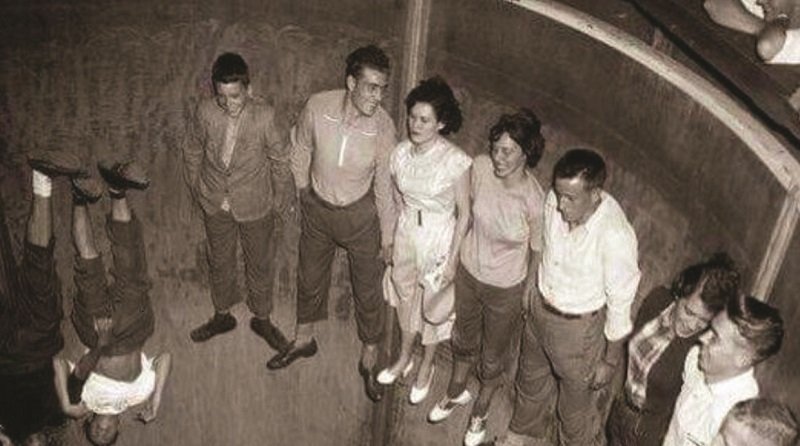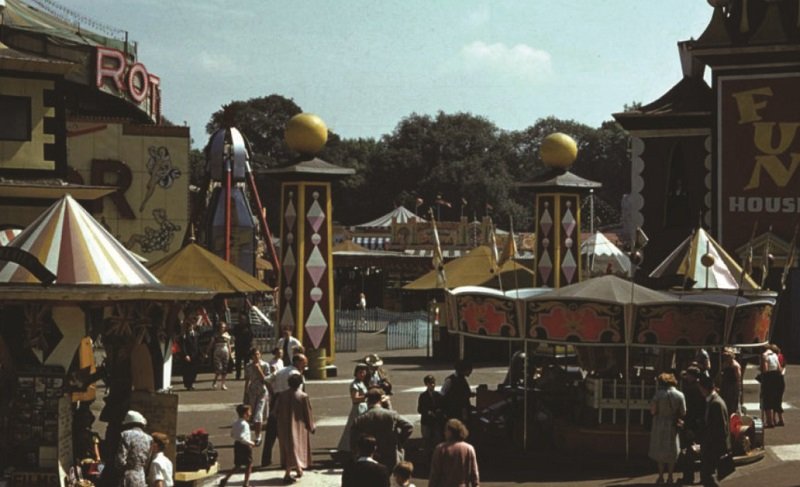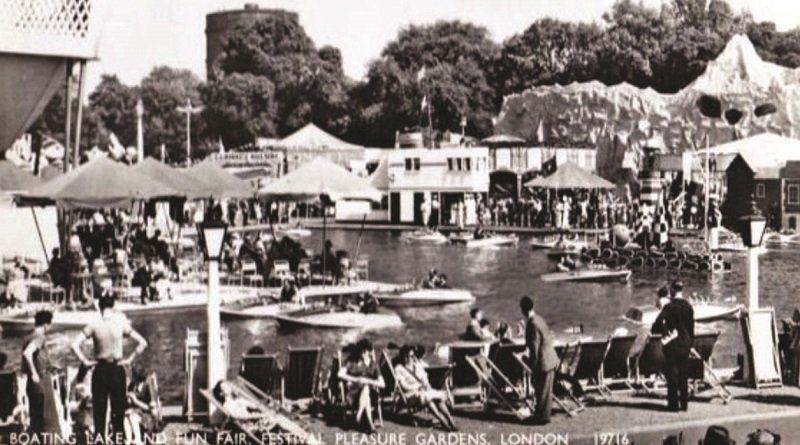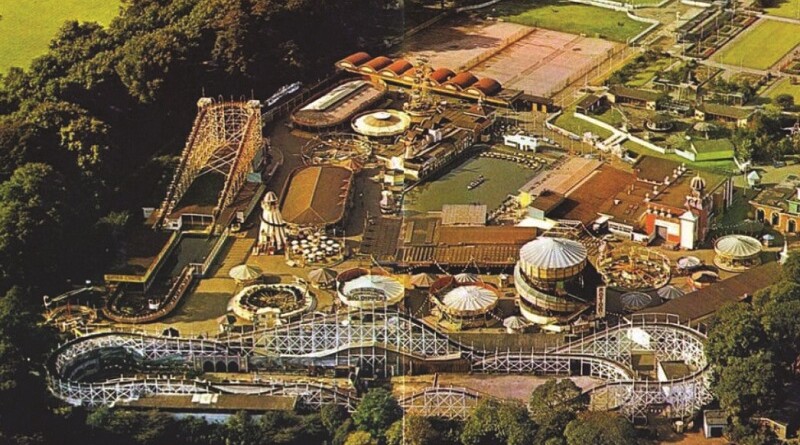South London Memories: Battersea Fun Fair the fairground attraction that turned into a disaster…
Battersea Fun Fair has been overlooked in the history of the Festival of Britain. But for many years, before Thorpe Park or Legoland, this was London’s amusement park and touched millions of lives over its 24 year existence.
Here NICK LAISTER and TOBY PORTER look at the history and we publish some extracts from his new book on London’s first modern amusement park – which was closed down when five children were killed and 13 injured in the Big Dipper tragedy of 1972.
Battersea Fun Fair opened in May 1951 and outlasted most of the prestigious exhibits on London’s South Bank.
The fair could well be seen as Britain’s first theme park – pre-dating Disneyland by four years.
It was themed around an imaginary Olde England and a futuristic theme.
Battersea Park was chosen as the venue for the lighter, more frivolous side of the Festival of Britain. It was the brainchild of Festival mastermind Gerald Barry.

He felt the ideas being developed for the South Bank rather too clinical for his tastes, with Barry accusing architects and scientists of “running away with it”.
At the time, the proposed Pleasure Gardens section of Battersea Park was still in use as post-wartime allotments and a cricket pitch.
It was designed for just one year’s operation – but survived for more than two decades. According to Becky Conkin’s Architect’s Journal article Fun and Fantasy, Escape and Edification, the Pleasure Gardens offered visitors an “amusement park, a children’s zoo and pet corner, two theatres, one dedicated to music hall performances, the other to ballets, revues and marionettes, a fanciful tree-top walk, a Mississippi Showboat, and a huge tented performance pavilion”.
The Fun Fair occupied only nine acres out of the 37-acre gardens. It was smaller than most of the major seaside amusement parks like the 1924 Wembley Exhibition, Blackpool’s Pleasure Beach, Margate’s Dreamland and Southend’s Kursaal.
But it was bigger than Great Yarmouth’s nine acres.
But Battersea was affectionately regarded as London’s seaside fun park. Its location in the capital could draw on a huge population and remains, even today, better remembered than most lost coastal parks.

Co-author Nick Laister, who has previously written about amusement history and was instrumental in rebuilding Margate’s historic Dreamland amusement park, said: “The story of Battersea Fun Fair has always fascinated me.
It is probably now sadly best remembered because of the Big Dipper tragedy in the early 1970s, but the park had a colourful history.
“I have been researching this book now for about 17 years, contacting people who visited the park or who worked there.
“These people have told me some incredible stories, and some even had photographs of the park, which are being published for the first time in this book. I am delighted that we are able to finally see it published.”
The rides removed at the end of the first year give a flavour of what the 1950s regarded as fun: Whittingham’s Ark, Hoadley’s Maxwell built Toboggan, Mont Blanc, Bubble Bounce, Boomerang, Loop–O–Plane, and the Sky Wheels.
But there were almost 2.5million admissions the following year.
The organisers constantly updated the mix of rides and always incorporated the latest attractions, making it a showcase for the whole country.
In the park’s initial years there was a very attractive ambiance created by the artistic and floral displays, but the approach changed.

New for 1954 were John Crowle’s Gallopers, Harry Gray’s Swirl & Chairs, J. Ling’s Moon Rocket and Botton’s Dive Bomber. Fresh Juvenile rides included a Double Decker and two Peter Pan attractions.
Head of the operation Leslie Joseph explained that the Gardens and Fun Fair were to be less arty and more gaudy.
He said: “This is what people expect and we intend to give them what they want. We aim to pack the rides and shows much closer together to create a more exciting atmosphere.”
In the centenary year of Battersea Park’s grand opening by Queen Victoria, 1958, Diana Dors opened the Fun Fair on Saturday, April 5, where she unveiled a special champagne fountain. New rides included the Globe Of Death and Harry Gray’s Flying Saucers Wheel.
In 1960, John Biddall’s Hurricane Jets was the year’s new attraction. It survived at Battersea until the park’s closure in 1974.
More than 10,000 bags of popcorn were sold during the Easter opening. During the week starting May 23, Sammy Davis Jnr was filmed in the park for his ABC TV spectacular.
Choreographer was Lionel Blair, for the hour-long musical with an ITV transmission on June 11, 1960.
Co-author Robert Preedy, who has written several books on the history of amusement parks, roller coasters and cinema, said: “I was on duty at BBC Radio London on the afternoon of the Big Dipper accident.
“I was part of the team that had to organise a reporter and a radio car to the site for live reports throughout the afternoon.
“This book entailed many hours of research at the British Library, combing the World’s Fair and national newspapers. There are many books about the Festival of Britain, but none on the Festival Gardens and Fun Fair.
Hopefully our book fills a gap.”

From screams of joy, to the screams of terror…
Battersea’s most famous ride was the Big Dipper, a notable presence on the park’s skyline that attracted long queues.
It was the London Eye of its day. The Duchess of Kent and her children took a ride in the three-car wooden rollercoaster in its opening year, while the Bolshoi Ballet climbed aboard in 1965.
But late in the afternoon of May 30, 1972, tragedy struck. Thirty one people had boarded a three-car wooden train.
As it reached the top of the first incline, some 15 metres above the park, it was prematurely detached from the drive chain.
Despite the best efforts of the brake man, the train slipped backwards under its own momentum on a 1 in 3 gradient. At the bottom, it hit a tight turn and derailed. The lower carriage was crumpled by those behind. Two teenage boys and an eight-year-old girl died at the scene, and two other children died later.
Carolyn Adamczyk, a passenger on the ride during the accident, said: “As soon as we started shooting backwards everything went into slow motion. I turned around and saw the brake man desperately trying to put the brake on but it wasn’t working. Most of the carriages didn’t go around the bend, one detached and went off the side through a wooden hoarding. People were groaning and hanging over the edge. It was awful.”
The disaster led to a review of fairground safety, and several charges of manslaughter. Prosecutors described the ride as a ‘death trap’, citing dozens of flaws and safety concerns. Despite the accusations, the park’s general manager and the ride’s engineer were both cleared of the charges in November 1973.
It wasn’t the first mishap on the ride. In May 1951, an empty car derailed, knocking over a parapet. Nobody was hurt on that occasion, although several passengers were marooned for 20 minutes.
A similar incident to the fatal crash seems to have occurred in 1968, when a woman broke her arm. In May 1970, £400,000 worth of damage was inflicted on the ride following a suspected arson attack. It was closed for two months.
A post-crash investigation revealed 51 faults on the ride.
Not one person or any party was held responsible nor found guilty of causing the accident – a shocking verdict after the loss of five young lives.
The Big Dipper was permanently closed and dismantled soon after the 1972 accident. It was replaced by a more modern steel roller coaster known as The Cyclone. But the iconic dipper’s retirement led to a swift decline.
Coupled with development wrangles, the fair’s fortunes dwindled until it finally closed in 1974. Temporary fair-grounds would occasionally set up in the park throughout the 1970s, but a permanent attraction like that established in 1951 would never again take root.
Battersea Fun Fair operated for the final time on Sunday, September 22. Many of the classic rides were advertised for quick sale as the site had to be cleared by early October.

The fire wasn’t arson. It was negligence. Someone, who shall remain nameless, was supposed to be carrying out maintenance work but was instead satisfying his carnal lust in the back of store room. When he’d finished, he discovered that his lack of attention had resulted in a machine overheating and bursting into flames. The miscreant is still alive and living in Sheffield. He is a member of a notorious South London family. File this under apocryphal as I heard it second hand.
Battersea Fum fair holds such memories for me. I went there with my mother and have never forgot the excitement. I must have been about 7, now in my 70s.
What a sad end to a fun and exciting place that had thrilled millions of visitors for nearly a quarter of a century. One wonders what would have become of the pleasure gardens and fun fair had the big dipper been maintained properly and the terrible tragedy that occurred as a result of gross negligence avoided. Perhaps the amusement area would still be thriving, evolving and expanding today in the same way other classic amusement parks that have been beautifully maintained have been able to, and London would still possess its very own Tivoli Gardens.
Reading Nick Laister and Robert Preedy’s recently published book about the history of Battersea fun fair it’s easy to see why the amusement area began to suffer in later years, the unsavoury characters it began to attract, reports of vandalism and other criminal activities as described by former employees. Contrasting later images of the fairground in its decline with the imagineering and inventiveness of its earlier years it is possible to see how social change in the decades in which the fun fair operated affected attitudes to how it was maintained and eventually allowed to fall into neglect. The upside of this intriguing and detailed book is the recollection of happy and memorable times spent at the park by visitors and employees alike, some very funny and insightful and a fascinating look at how the pleasure gardens and fun fair were first envisaged for the Festival of Britain.
As a 15 year old and living across the Chelsea Bridge at Embankment Gardens, my sister and I worked at Battersea park, I worked in the Ice Cream, Toffee Apple and Candy Floss stall in the park, no health and safety back then for a 15 year old who dipped apple into big vats of boiling sugar water, or made candy floss in a very fast spinning drum, but it was a very exciting time to be working there, and being paid £12.00 yes £12.00 per week a lot of money for a 15 year old girl to get bank in the late 50’s. I moved into the funfair and carried on with the toffee apple and candy floss making, I was in the kiosk next to the boating lake, I then moved to the rifle range, got very good at shooting down the moving ducks, but again no health and safety. I doubt it would be allowed today, but at nearly 76 years of age it holds very fond memories.
As a young lad (12-13yrs) me and my friends used to visit the fair nearly everyday from its opening after the Easter parade to closure at the end of summer (circa 1974-77). We’d identify numerous ways to ‘bunk’ in for free and spent our time around the arcades rather than the rides which havig ridden many, many times, we had tired of. It became a bit of a job really. We’d meet up after school, bunk in then proceed to find ways of scamming the various arcade games e.g. banging the shove ‘penny’ games to tilt the coins over. Follow visitors around who played the1-armed bandits and identify when the machines were due to payout after they had ‘fed the up’ to enjoy taking jackpots, and play the unused credits built up on pinball machines which casual players didn’t realise they’d won. We alsohad a scam where we’d sneak into the back of the cafe in the fair, remove their empty returnable coke bottles and ‘cash them in in local corner shops – returning to the fair to spend the gains on the machines. It was a great time of my life – a little ‘self employed – Artful Dodgering!’
Interesting article but the listing of rides by year is at odds with the account published in the Fairground Mercury (Vol 14 No 3 – December 1991) by Phillip Bradley.
On the 3rd September 1963 I arrived in London from Ireland at Euston Station aged 18 years. I deposited my suitcase in Left Luggage and made my way on the 19 bus to Battersea Funfair ( this was before I had even found accommodation for that night so desperate was I to ride on the Rollercoaster having never done so in Dublin where there wasn’t one it did not disappoint) I returned to the fair many times over the year with the rotor being another great thrilling ride. Happy Days.
I was taken to the fair by my father, who had recently returned from the East with the RAF. I hardly knew him. We went to a rifle range stall where he won a big prize and I was asked to me to chose and as I was 6 I chose a huge teddy bear but he suggested that as my mother hadnt been able be with us, as she was working, I should chose something for her and suggested a garish necklace, so regretfully I handed the teddy back and even though I was only 6 I knew she would hate that necklace.
In nineteen sixty one, when I was seventeen, I visited Battersea Fun Fair on several occasions. On one occasion I noticed a booth bearing a sign saying to “Come in and see The Wowl” alongside was a picture of an owl with a woman’s head on a perch in a bird cage.
I bought my ticket and went in. Being a cheeky lad I asked the “Wowl” if she would meet me on her lunch break, to which she agreed. We met and she explained how the illusion worked, also explaining that she was fifteen years of age.
We had our photograph taken together in a black and white booth, then we parted and I never saw her again. I have that photo to this day and still wonder what became of her as she would now be seventy seven years of age.